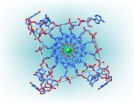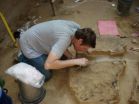(Press-News.org) PHILADELPHIA - Researchers at the University of Pennsylvania School of Medicine are delving into the details of the complex structure at the ends of chromosomes. Recent work, e-published in Nature Structural & Molecular Biology last month, describes how these structures, called telomeres, can be protected by caps made up of specialized proteins and stacks of DNA called G-quadruplexes, or "G4 DNA." Telomere caps are like a knot at the end of each chromosome "string," with the knot's role preventing the string from unraveling.
"Although G4 DNA has been studied in test tubes for years, we did not know whether it could contribute to telomere protection in actual cells until we performed our studies in yeast cells," stated F. Brad Johnson, MD, PhD, associate professor of Pathology and Laboratory Medicine.
The composition of the particular G4-molecular "knot" studied is complex and unusual, involving a DNA sequence with guanine building blocks that loop back and forth on top of each other to form a four-stranded stack, which is different from the two-stranded arrangement of typical DNA molecules. The stack protects the chromosome from unraveling by specialized enzymes.
The length of telomeres is associated with age. Shortened telomeres are observed in aging cells and in some rare syndromes. There is mounting evidence that loss of telomere capping may contribute to some diseases that become more common with natural aging. An example of extreme aging associated with telomere defects is Werner syndrome, a rare genetic disease in which individuals develop normally until puberty. After this they age rapidly, so that by age 40 or so they often appear several decades older.
The protein missing in people with Werner syndrome but present in healthy people, is a helicase, an enzyme that unzips DNA. A slightly different G4-unwinding helicase is missing in people with a related disease, called Bloom syndrome, which is characterized by chromosome instability and high rates of cancer. It's possible that changes in G4 DNA contribute to the symptoms of these two syndromes.
The normal unwinding of DNA is critical under many particular circumstances, for example during replication. There are hundreds of different types DNA helicases in human cells, and each unwinds DNA under different circumstances. Although it is important to keep the strands of DNA together most of the time, if they can't be unwound when needed, serious problems could occur.
The Penn researchers hope to eventually explore the role of G4 capping in human aging after they know more about the G4 cap in yeast cells, which are easy to study because they can be engineered to make very specific changes in their DNA and proteins.
Recently, Johnson's group found that DNA sequences with the potential to form G4 DNA, which exist not only at telomeres but also at many locations throughout the entire human genome, are closely connected to changes in gene expression in cells from people with Werner or Bloom syndrome. They predict that G4 DNA abnormalities also exist at the telomeres in these human diseases and perhaps those of aging cells.
In their experiments in which telomeres were specifically examined in yeast, both elevated levels of G4 binding protein and inactivation of the yeast helicase that is similar to the one missing in human Werner and Bloom syndrome patients led to increased protection of the telomeres. This suggested that the G4 caps were present on the telomeres and that they protected the telomere from breaking down.
The overall role of G4 DNA is not simple and might seem to be contradictory. For example, work from several other research groups has suggested that G4 DNA can interfere with the replication and capping of telomeres, in contrast to the protective role observed by Johnson's group.
"This points out the complexity of G4 DNA," said Johnson. "On one hand, some G4 DNA may help cap telomeres, but too much G4 DNA or formation of G4 DNA at the wrong times or places may be detrimental. G4 DNA is not a single thing, but is rather a family of related structures, and so it might be possible to target particular types of G4 DNA to, for example, improve telomere capping in normal cells or disrupt the growth of cancer cells. This is a very new field, and it will be fun to see how far it might go."
This study was supported by grants from the National Institute on Aging. The lead author, Jasmine S. Smith, PhD performed this study as part of her Ph.D. dissertation research, which grew from studies begun by the second author, Qijun Chen, PhD. Dr. Liliya Yatsunyk's lab at Swarthmore College performed many of the studies on G4 DNA structure.
INFORMATION:
Penn Medicine is one of the world's leading academic medical centers, dedicated to the related missions of medical education, biomedical research, and excellence in patient care. Penn Medicine consists of the University of Pennsylvania School of Medicine (founded in 1765 as the nation's first medical school) and the University of Pennsylvania Health System, which together form a $4 billion enterprise.
Penn's School of Medicine is currently ranked #2 in U.S. News & World Report's survey of research-oriented medical schools and among the top 10 schools for primary care. The School is consistently among the nation's top recipients of funding from the National Institutes of Health, with $507.6 million awarded in the 2010 fiscal year.
The University of Pennsylvania Health System's patient care facilities include: The Hospital of the University of Pennsylvania â€" recognized as one of the nation's top 10 hospitals by U.S. News & World Report; Penn Presbyterian Medical Center; and Pennsylvania Hospital – the nation's first hospital, founded in 1751. Penn Medicine also includes additional patient care facilities and services throughout the Philadelphia region.
Penn Medicine is committed to improving lives and health through a variety of community-based programs and activities. In fiscal year 2010, Penn Medicine provided $788 million to benefit our community.
Ends of chromosomes protected by stacked, coiled DNA caps
Implications for studying human aging, Werner syndrome and Bloom syndrome
2011-04-21
ELSE PRESS RELEASES FROM THIS DATE:
Littlewoods Europe Announces Launch of Coleen Rooney Range
2011-04-21
Littlewoods Europe has announced it will be stocking the new season range from Coleen Rooney.
The range was previously only available in the UK but Littlewoods Europe customers will now be able to choose from Coleen Rooney's range of clothes including women's coats, women's dresses, women's shoes, bedding, curtains, perfume and cosmetics.
Coleen's newest range is inspired by the latest trends, and has been hugely popular in the UK already, receiving lots of press coverage and fashion features.
The new range will now be available to the 25 European countries ...
Aces High Offers New Scenario, The Road to Rangoon
2011-04-21
HiTech Creations is offering a new scenario, Road To Rangoon, for gamers on their highly popular online WWII combat simulation, Aces High. Registration has already begun and will continue throughout the month of April.
Road To Rangoon offers players a chance to reenact one of the early aerial engagements in the Pacific Theater during World War II. Japan was determined to cut off China from the rest of the world and to do so they needed to shut down the main supply line to China, the Burma Road. In late December of 1941 Japan launched a series of bombing runs against ...
Laser sparks revolution in internal combustion engines
2011-04-21
WASHINGTON, April 20—For more than 150 years, spark plugs have powered internal combustion engines. Automakers are now one step closer to being able to replace this long-standing technology with laser igniters, which will enable cleaner, more efficient, and more economical vehicles.
In the past, lasers strong enough to ignite an engine's air-fuel mixtures were too large to fit under an automobile's hood. At this year's Conference on Lasers and Electro Optics (CLEO: 2011), to be held in Baltimore May 1 - 6, researchers from Japan will describe the first multibeam laser ...
Protein and calories can help lessen effects of severe traumatic brain injury
2011-04-21
WASHINGTON — To help alleviate the effects of severe traumatic brain injury (TBI), the U.S. Department of Defense should ensure that all military personnel with this type of injury receive adequate protein and calories immediately after the trauma and through the first two weeks of treatment, says a new report from the Institute of Medicine. Evidence from several studies of severely brain-injured patients shows that providing energy and protein to patients early reduces inflammation and improves their outcomes, said the committee of experts who wrote the report.
This ...
Biological links found between childhood abuse and adolescent depression
2011-04-21
Queen's University professor Kate Harkness has found that a history of physical, sexual or emotional abuse in childhood substantially increases the risk of depression in adolescence by altering a person's neuroendocrine response to stress.
Adolescents with a history of maltreatment and a mild level of depression were found to release much more of the stress hormone cortisol than is normal in response to psychological stressors such as giving a speech or solving a difficult arithmetic test.
"This kind of reaction is a problem because cortisol kills cells in areas of ...
Air pollution exposure affects chances of developing premenopausal breast cancer
2011-04-21
BUFFALO, NY -- Exposure to air pollution early in life and when a woman gives birth to her first child may alter her DNA and may be associated with premenopausal breast cancer later in life, researchers at the University at Buffalo have shown.
The findings indicated that higher air pollution exposure at birth may alter DNA methylation, which may increase levels of E-cadherin, a protein important to the adhesion of cells, a function that plays an essential role in maintaining a stable cellular environment and assuring healthy tissues.
Methylation is a chemical process ...
Evolution of human 'super-brain' tied to development of bipedalism, tool-making
2011-04-21
Scientists seeking to understand the origin of the human mind may want to look to honeybees -- not ancestral apes -- for at least some of the answers, according to a University of Colorado Boulder archaeologist.
CU-Boulder Research Associate John Hoffecker said there is abundant fossil and archaeological evidence for the evolution of the human mind, including its unique power to create a potentially infinite variety of thoughts expressed in the form of sentences, art and technologies. He attributes the evolving power of the mind to the formation of what he calls the ...
Researchers combine active proteins with material derived from fruit fly
2011-04-21
Researchers at Rice University and Texas A&M have discovered a way to pattern active proteins into bio-friendly fibers. The "eureka" moment came about because somebody forgot to clean up the lab one night.
The new work from the Rice lab of biochemist Kathleen Matthews, in collaboration with former Rice faculty fellow and current Texas A&M assistant professor Sarah Bondos, simplifies the process of making materials with fully functional proteins. Such materials could find extensive use as chemical catalysts and biosensors and in tissue engineering, for starters.
Their ...
30th annual survey shows Houstonians upbeat about city's future
2011-04-21
Despite economic anxiety and concern for the future of the country, most Houstonians perceive an improving quality of life locally and 90 percent believe that Houston is a better place to live than most other metropolitan areas, according to the 30th annual Kinder Houston Area Survey conducted by Rice University. The findings were released today during a luncheon hosted by the Greater Houston Partnership and Rice's Kinder Institute for Urban Research.
The survey showed that Harris County residents have become a little more upbeat in their personal economic outlooks ...
New data shows half of all children with autism wander and bolt from safe places
2011-04-21
(Baltimore, MD) – Today, the Interactive Autism Network (IAN), www.ianproject.org, the nation's largest online autism research project, reveals the preliminary results of the first major survey on wandering and elopement among individuals with autism spectrum disorders (ASD), and announces the launch of a new research survey on the association between pregnancy factors and ASD. The wandering and elopement survey found that approximately half of parents of children with autism report that their child elopes, with the behavior peaking at age four. Among these families, nearly ...
LAST 30 PRESS RELEASES:
Making lighter work of calculating fluid and heat flow
Normalizing blood sugar can halve heart attack risk
Lowering blood sugar cuts heart attack risk in people with prediabetes
Study links genetic variants to risk of blinding eye disease in premature infants
Non-opioid ‘pain sponge’ therapy halts cartilage degeneration and relieves chronic pain
AI can pick up cultural values by mimicking how kids learn
China’s ecological redlines offer fast track to 30 x 30 global conservation goal
Invisible indoor threats: emerging household contaminants and their growing risks to human health
Adding antibody treatment to chemo boosts outcomes for children with rare cancer
Germline pathogenic variants among women without a history of breast cancer
Tanning beds triple melanoma risk, potentially causing broad DNA damage
Unique bond identified as key to viral infection speed
Indoor tanning makes youthful skin much older on a genetic level
Mouse model sheds new light on the causes and potential solutions to human GI problems linked to muscular dystrophy
The Journal of Nuclear Medicine ahead-of-print tip sheet: December 12, 2025
Smarter tools for peering into the microscopic world
Applications open for funding to conduct research in the Kinsey Institute archives
Global measure underestimates the severity of food insecurity
Child survivors of critical illness are missing out on timely follow up care
Risk-based vs annual breast cancer screening / the WISDOM randomized clinical trial
University of Toronto launches Electric Vehicle Innovation Ontario to accelerate advanced EV technologies and build Canada’s innovation advantage
Early relapse predicts poor outcomes in aggressive blood cancer
American College of Lifestyle Medicine applauds two CMS models aligned with lifestyle medicine practice and reimbursement
Clinical trial finds cannabis use not a barrier to quitting nicotine vaping
Supplemental nutrition assistance program policies and food insecurity
Switching immune cells to “night mode” could limit damage after a heart attack, study suggests
URI-based Global RIghts Project report spotlights continued troubling trends in worldwide inhumane treatment
Neutrophils are less aggressive at night, explaining why nighttime heart attacks cause less damage than daytime events
Menopausal hormone therapy may not pose breast cancer risk for women with BRCA mutations
Mobile health tool may improve quality of life for adolescent and young adult breast cancer survivors
[Press-News.org] Ends of chromosomes protected by stacked, coiled DNA capsImplications for studying human aging, Werner syndrome and Bloom syndrome


